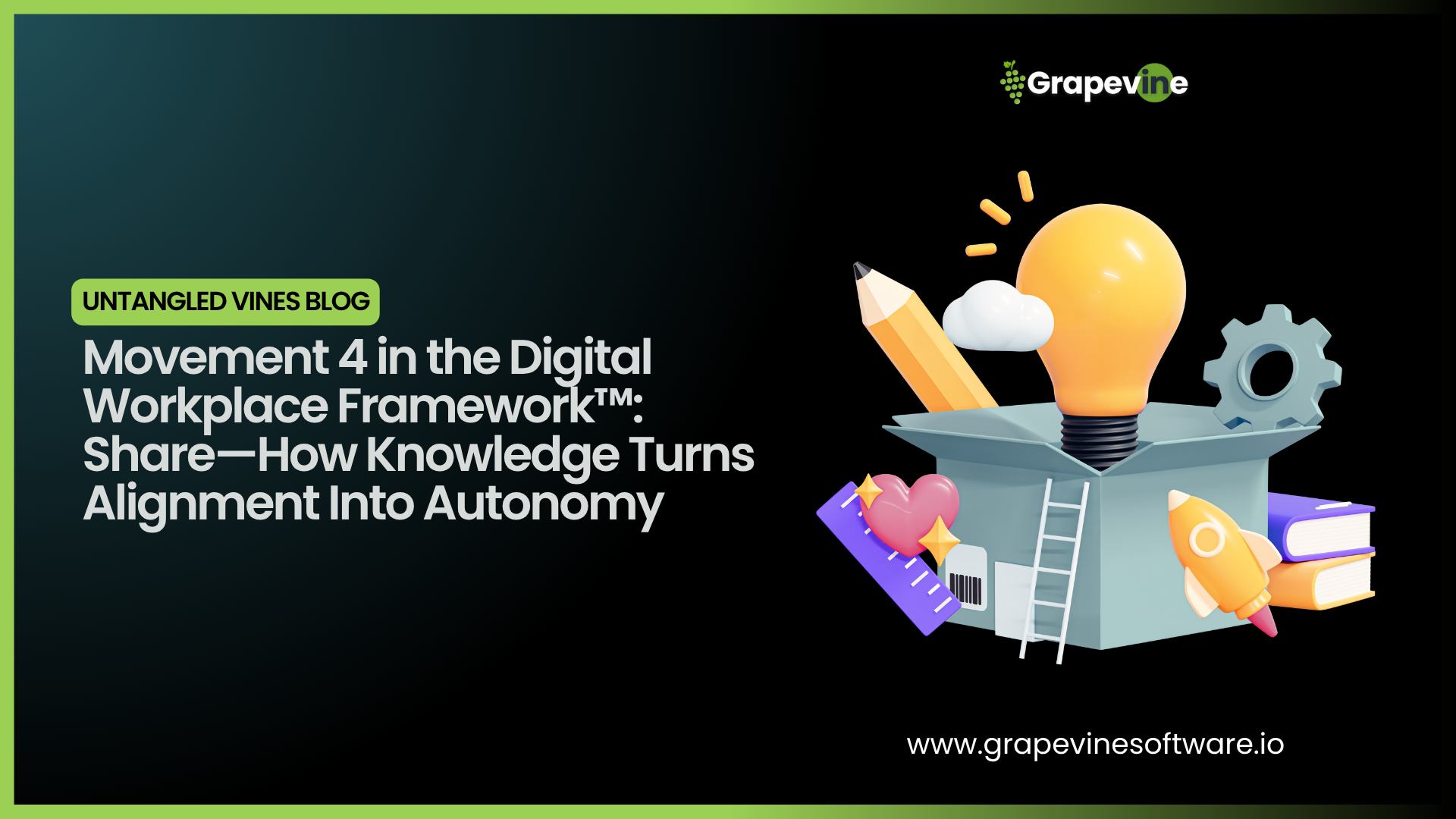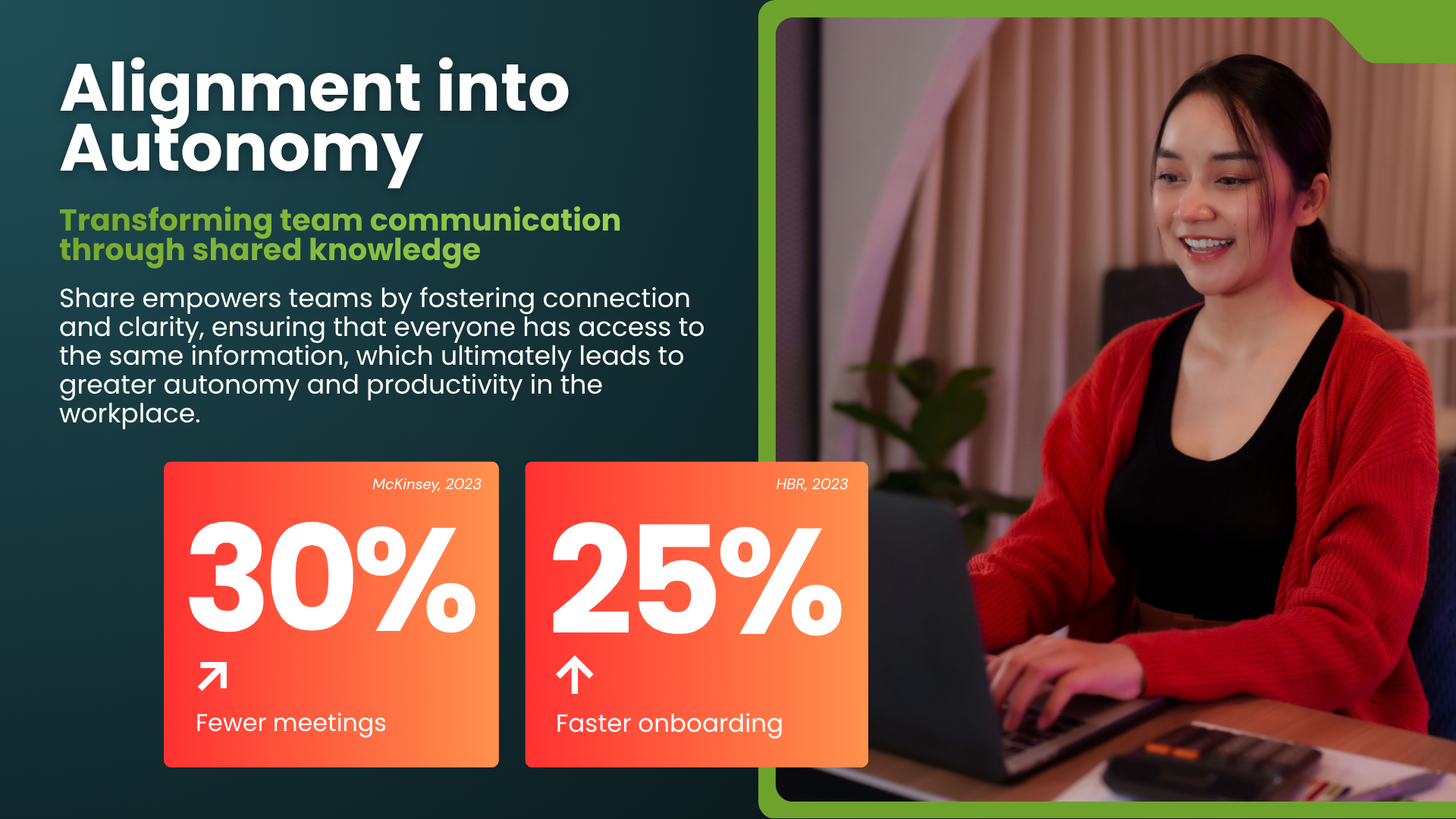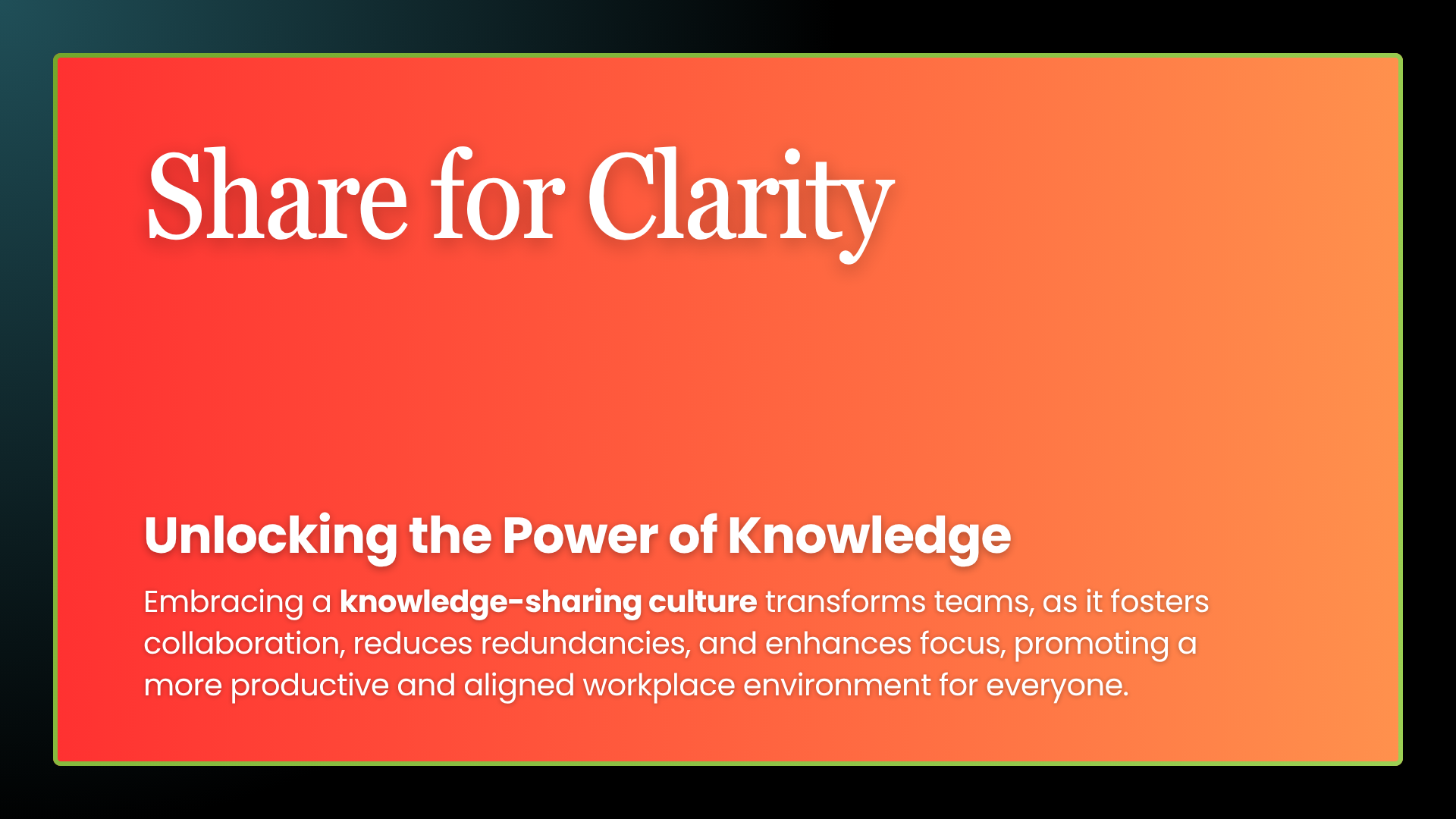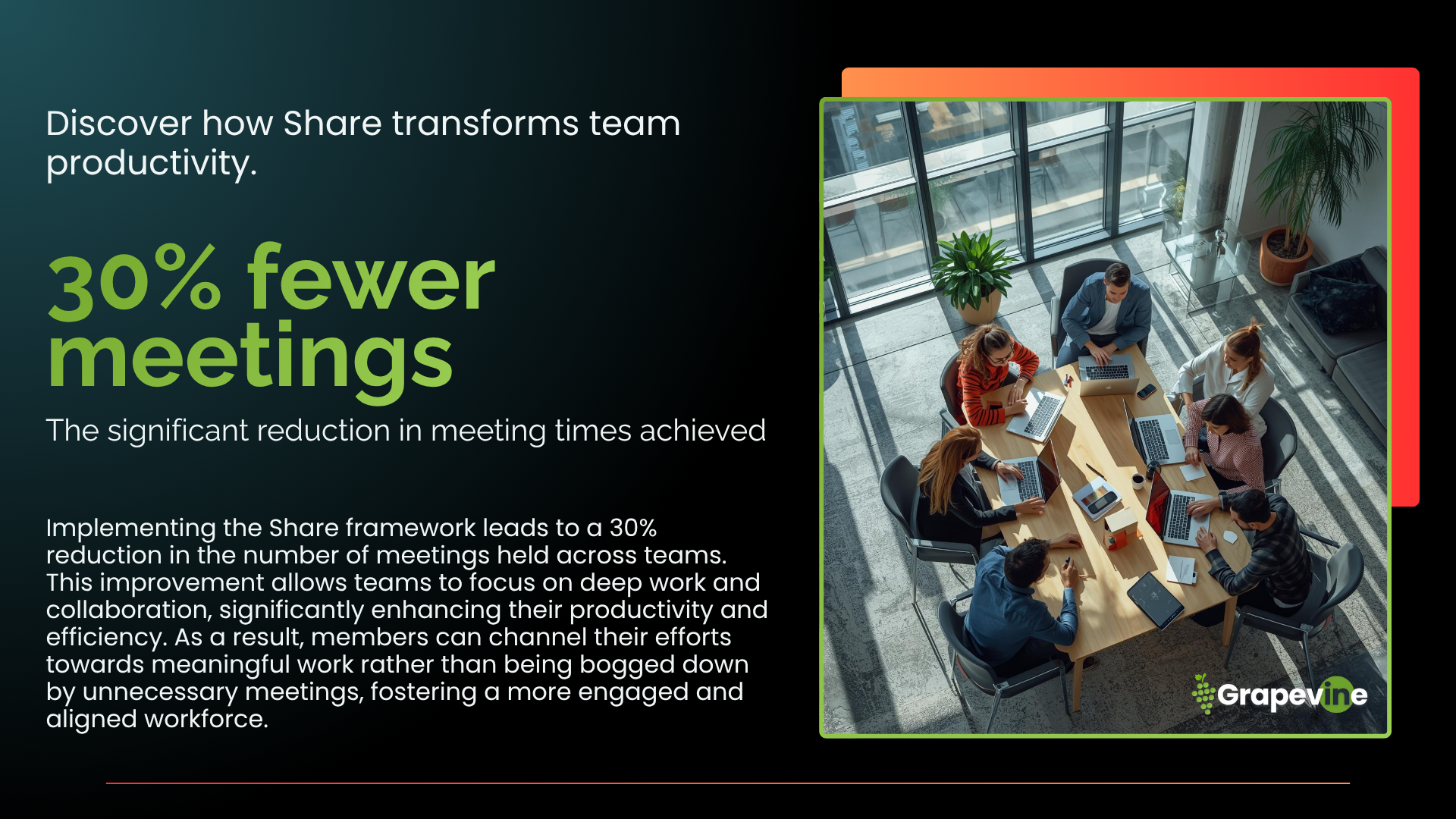Movement 4 in the Digital Workplace Framework™:
Share—How Knowledge Turns Alignment Into Autonomy

The Rhythm of Modern Work: Why “Share” Keeps the Music Playing
Work isn’t linear. It’s choreography.
Each movement in the Grapevine Digital Workplace Framework™—Sync, Align, Focus, Share, and Connect—interacts like performers on a stage.
When one misses a beat, the whole performance stumbles.
Most organizations understand the opening acts:
They meet (Sync) to decide, communicate (Align) to inform, and carve time for deep work (Focus) to create.
But somewhere between decision and documentation, momentum is lost.
That gap—the silent space between what was said and what was saved—is where alignment dies.
Share fills that silence.
It ensures that every insight, update, and decision lives beyond the moment—structured, searchable, and shared.
Share is the connective tissue that makes the rhythm of modern work sustainable.
Without it, every act fades when the curtain closes.

Why Share Matters More Than Ever
Modern work moves faster than memory.
- Employees spend 2.5 hours every day searching for existing information (McKinsey).
- 49% of work is duplicated because teams can’t find what’s already done (IDC).
- Each “quick catch-up” consumes 4.5 hours of collective focus (HBR).
This isn’t a people problem—it’s an infrastructure problem.
The modern workplace has become a maze of tools with no connective tissue.
Share provides that connection: it transforms fragmented data into institutional memory.
When knowledge lives in one structured, searchable place, teams stop losing hours to “Who has the link?” and start building on what already exists.

From Meetings to Memory: How Share Completes the Loop
Picture your workweek as choreography:
1️⃣ Sync — The live act. Real-time energy, creativity, decision-making.
2️⃣ Align — The cue sheet. Everyone knows the next steps, asynchronously.
3️⃣ Focus — The solo or team performances. Deep, meaningful progress without distraction.
4️⃣ Share — The documentation and recording. The reason you can rehearse, improve, and scale the show.
Without Share, the first three movements are temporary.
With Share, they become transferable.
Share turns alignment into autonomy. It’s what lets teams operate confidently without needing to re-meet, re-ask, or re-explain.

The Truth About Share
Share isn’t documentation for its own sake — it’s the design of visibility. Which is extremely critical in the new landscape of the workplace.
It answers three fundamental questions every digital workplace must be able to answer instantly:
1️⃣ Where does this live?
2️⃣ Who needs to see it?
3️⃣ How will others find it later?
When those answers are clear, async work becomes sustainable.
Teams move faster, with fewer interruptions.
Leaders don’t rely on memory, they rely on systems.
Share is what turns Sync decisions and Align updates into the long-term structure that protects Focus and business continuity for when employees leave with tribal knowledge. Share encourages the storage of knowledge and information in a systemic manner rather than having that knowledge live in someone's brain or tucked away in a long-lost Google Drive file.
.png)
The 3 Safeguards in Action
Every movement in the Framework is governed by three universal safeguards: Structured, Searchable, Shared.
In the Share movement, these aren’t abstract — they’re operational.
Safeguards: What It Means in Practice and Why It Matters Now
- Structured: Capture outcomes in consistent formats — SOPs, playbooks, templates, meeting recaps. Prevents information rot and “tribal knowledge.”
- Searchable: Tag, categorize, and index everything. Use AI search or a platform like Grapevine InfoHub to retrieve in seconds. Cuts wasted hours and duplication.
- Shared: Publish knowledge in open, visible spaces — not private folders or chats. Keeps cross-team alignment alive across time zones.
Together, these safeguards make knowledge a living system rather than a static archive.
And they double as diagnostic tools: whenever something breaks down, ask:
“Was it structured? Was it searchable? Was it shared?”
If not, you’ve found the weak spot in your system.
.gif)
The Chain Reaction: How Share Protects Focus and Reduces Sync Reliance
When knowledge is structured, searchable, and shared:
- Async Align thrives. Updates stay visible without disruption.
- Focus is protected. Employees can self-serve answers instead of waiting.
- Sync load drops. Fewer recurring meetings, fewer status calls.
Leaders no longer need to restate decisions — because everyone can revisit them.
Teams don’t need to pause for clarity — because clarity is built in.
That’s the hidden power of Share: it creates time by eliminating repetition and allowing employees to still know the exact details they need for faster execution due to reduction of reliance on real-time responses from others who might be in different time-zones or offline at the time.

How to Implement Share in Your Digital Workplace
1️⃣ Establish a Shared Knowledge Hub
Centralize all recurring outcomes — meeting notes, SOPs, decisions, FAQs — into one searchable system.
Tools like Grapevine InfoHub for external files and Spaces for internal knowledge base to let you organize by team or project while keeping company-wide visibility. And Grapevine Workplace is how you track and measure your team's outputs. The combination truly gives you the Digital Workplace Operating System.
2️⃣ Define Ownership and Format
Every recurring conversation should have an owner and a template.
Ask:
- Who captures outcomes?
- Where do they live?
- How do others find them later?
Clarity on these three answers ensures sustainability.
3️⃣ Integrate Share into Every Movement
- After Sync: document decisions and actions.
- During Align: link updates to source material.
- Before Focus: reference existing documentation to prevent rework.
- Inside Connect: celebrate knowledge contributions and recognize contributors.
4️⃣ Measure Your “Share Health”
Ask these diagnostic questions:
- Can employees find key information in under 30 seconds?
- Are decisions visible beyond the team that made them?
- Does documentation evolve instead of stagnate?
If any answer is “no,” you’re not sharing — you’re storing.
Case in Point: How Share Lives Inside Grapevine Workplace
Inside Grapevine HQ + Workplace, the Share movement is baked into every workflow:
- Sync: Teams collaborate in real time through figgyChat or Instant Meet.
- Align: Updates move asynchronously via Spaces or InfoHub. They track and measure their goals, projects, 1-on-1s, and personal productivity in Workplace.
- Share: Outcomes automatically feed into a structured, searchable layer. figgyChat, postings updates in Grapevine HQ from InfoHub, Spaces, Notes, and more.
- Focus: Employees reclaim hours of uninterrupted deep work while being able to easily access the resources needed to keep the work flowing forward.
- Connect: Knowledge flows into recognition — celebrating contributors across the company. From culture posts to recognition in Workplace to details profiles to AI assistant smart connection recommendations across your teams based on goals, activity, and more.
It’s not five separate tools.
It’s one connected rhythm; the modern company’s choreography of work.

The Leadership Shift: From “Ask Me” to “It’s Already There”
In high-performing digital workplaces, leadership doesn’t scale through presence — it scales through clarity.
Great leaders don’t hoard knowledge.
They design visibility.
They replace:
“Let’s sync on this.” with “Here’s where you can find it.”
This shift liberates both leaders and employees:
- Managers spend less time relaying information.
- Teams make faster, better-informed decisions.
- Culture shifts from permission to progress.

Why This Matters for Global Teams
For distributed teams across North America, Europe, and APAC, Share isn’t a convenience...it’s survival and avoidance of delayed progress.
Time zones mean someone is always offline.
By structuring and sharing knowledge:
- A decision in New York becomes visible in Sydney before sunrise.
- A policy update in London guides teams in Toronto without delay.
- A customer fix in Singapore informs product in Austin.
That’s what it means to work globally, not locally.
The ROI of Share
- 30% fewer recurring meetings (async visibility replaces updates).
- 25% faster onboarding (new hires self-serve knowledge).
- 40% reduction in duplicated work.
- Higher engagement scores tied to perceived clarity.
These aren’t productivity hacks — they’re structural gains.
How to Start Today
1️⃣ Audit your information flow. Identify what lives in chat, what’s lost, what’s duplicated.
2️⃣ Select or activate your shared system. (Hint: start with Grapevine InfoHub.)
3️⃣ Document one recurring process per week. Small habits scale clarity.
4️⃣ Reward sharing. Recognition fuels adoption.
By month’s end, you’ll have built your company’s first true Knowledge Infrastructure Layer — the foundation of sustainable alignment.
.png)
🧭 Deep Answers: What Makes Share Work in Modern Teams
Q: What does “Share” mean in the Digital Workplace Framework™?
Share is the system that transforms decisions and updates into structured, searchable, and shared knowledge. It ensures alignment lasts beyond meetings and enables async teams to work autonomously.
Q: Why do most teams struggle with knowledge sharing?
Because they rely on tools, not systems. Files scatter across apps, updates hide in threads, and nothing connects. Share fixes this by standardizing how and where knowledge lives.
Q: How does Share reduce meetings and improve focus?
When information is documented and accessible, employees don’t need to meet to find answers. Async updates and searchable knowledge eliminate redundant syncs, freeing time for deep work.
Q: How can leaders implement Share in their organization?
1️⃣ End every meeting with structured documentation.
2️⃣ Store outcomes in a shared, searchable hub.
3️⃣ Encourage employees to search before they ask.
4️⃣ Recognize those who contribute knowledge — culture makes systems stick.
Q: Does Share only matter for remote teams?
No. Whether teams are remote, hybrid, or in-office, Share is what keeps clarity intact. Proximity doesn’t replace documentation — structure does.
👉 Get Your Share Score
Find out how well your company shares what it knows with the Digital Workplace Framework Assessment — a free diagnostic that measures performance across Sync, Align, Focus, Share, and Connect.
.png)
The Takeaway
Share is not ONLY documentation—it’s design.
It’s the discipline that turns moments into systems, and systems into culture.
When knowledge becomes structured, searchable, and shared, alignment no longer depends on proximity or presence — it simply exists.
That’s how Sync, Align, Focus, and Share flow together — a living rhythm of modern work. And that rhythm is what keeps companies connected, creative, and clear — no matter where their people work.
The future of work isn’t about being remote or in-office — it’s about being structured or scattered.
The Grapevine Digital Workplace Framework™ gives leaders a model to:
- Sync for urgency.
- Align async for clarity.
- Focus deeply.
- Share knowledge.
- Connect people.
This is how companies thrive in the next decade of work.
Productivity in the future isn’t about doing more, it’s about designing better systems. Clear communication, visible goals, healthy boundaries, and centralized tools are what allow distributed teams to thrive.
That’s exactly why we built Grapevine HQ & Workplace.
The shift to distributed work didn’t create these problems—it exposed them. Communication gaps, tool sprawl, burnout, and culture drift aren’t “quirks of remote work.” They’re the result of trying to run today's teams with 2010 systems.
Companies that want to thrive need to rethink how they operate. That means building intentional structures for communication, knowledge management, connection, and security.
If you are ready to take the leap to fix these issue with Grapevine, either get started for free or let's chat today!
Related Resources
👉 Read: The Illusion of the Office — Why Work Needs a Digital Workplace Framework
👉 Sync vs. Align: Finding the Balance Between Real-Time and Async Work
👉 Movement 3 in The Digital Workplace Framework: Focus; The Forgotten Discipline of Modern Work
👉 Take: The Digital Workplace Framework Assessment
Additional Resources
- Top 8 Challenges for Remote & Hybrid Teams: And How to Overcome Them
- The Everything App vs. The Layer Above: A Strategic Guide for Distributed Teams
- The Evolution of Work: Why Every Company Needs a Virtual Office in the Hybrid Era
- Workvivo vs Grapevine: Which Internal Comms Platform Wins for Ops Leaders?
- Grapevine vs. "Them" Knowledge Management Done Right in the Workplace
- Centralization Is the New Collaboration
- Why Virtual HQs Are the Future of Work for Distributed Teams
- Never Lose Important Updates Again: How Centralized Platforms Solve the Problem of Scattered Communication & Information
- Navigating New Work: The Ultimate Remote Team Communication Guide
- Communication Strategies: The Distributed Teams Version
- The Ripple Effect of Communication Challenges: How Poor Internal Comms Impacts Your Bottom Line
- Streamline Your Virtual Workplace: How Grapevine Centralizes Communication & Knowledge
.png)